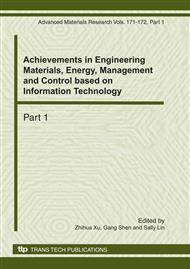p.223
p.231
p.235
p.240
p.246
p.252
p.256
p.261
p.266
Self-Adaptive Weighting Text Association Categorization Algorithm Research
Abstract:
In text association classification research, feature distribution of the training sample collection impacts greatly on the classification results, even with a same classification algorithm classification results will have obvious differences using different sample collections. In order to solve the problem, the stability of association classification is improved by the weighing method in the paper, the design realizes the association classification algorithms (WARC) based on rule weight. In the WARC algorithm, this paper proposes the concept of classification rule intensity and gives the concrete formula. Using rule intensity defines the rule adjustment factors that adjust uneven classification rules. Experimental results show the accuracy of text classification can be improved obviously by self-adaptive weighting.
Info:
Periodical:
Pages:
246-251
Citation:
Online since:
December 2010
Authors:
Price:
Сopyright:
© 2011 Trans Tech Publications Ltd. All Rights Reserved
Share:
Citation:


